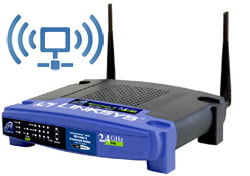Just twenty years ago, computers were technology that was not affordable by all. Its expensive price meant only the wealthy could afford and own one. Networks were something that only large corporations used to stay connected.
Looking at the turn of the century, just ten-year ago computers had become a necessity and almost everyone had one of their own. Even in the same house everyone had their own personal computer with no sharing. And now everyone has their very own desktop, laptop, tablet and smartphone. We have moved from dial-up connections to pre paid wireless broadband.
Now the struggle isn’t to sharing the same computer but to share the same internet connection. There are multiple ways through which more than one computer can use the same internet connection. However, all the solutions involve creating some sort of network. Traditionally computers could only be connected by the use of a physical medium like a coaxial cable. The recent launch of the wireless router has reduced all that pain by introducing a method of sharing the internet connection without having to go to lengths wiring your entire house.

Setting up a wireless network is extremely simple. The internet connection from a service provider is connected to the wireless router. The wireless router then broadcasts signals. Wireless antenna network cards are already embedded in our laptops, tablets, smartphones, netbooks, notebooks, etc. that catch the radio waves transmitted by the router and access the internet through them. But broadcasting your signal means you cannot contain it just within your house. It will travel the entire length of its radius. That means your neighbors can use it to access the internet from their devices as well and start freeloading. Or some hacker nearby can access your computer systems through the network.
This does not mean that there is no secure way of using wireless network. Just by taking a few basic precautions you can make your wireless network secure so that every Tom, Dick and Harrywon’t be able to access it.
Securing the Wireless Network
Here are a few simple ways by which you can secure your wireless network:
- Change your System ID: All wireless routers and pre paid wireless broadband devices come with a default SSID/ESSID that can be easily found out. Make sure you change it when you install the device.
- Disable the Identifier Broadcasting: You don’t really have to announce it to the whole world that you have a wireless connection. So disable the broadcasting feature.
- Enable Encryption: WEP and WPA are forms of encryption so that only your intended recipient can read the data.
- Build Firewalls: Most wireless devices come with basic built-in firewalls. Learn to activate them with the help of the user manual.
- Use an Administrator Password: Change the default password of the wireless device from the Admin panel.
- Patch your PC: Install personal firewall and antivirus softwares on your desktop, laptop and tablet PCs.
What is WEP and Should I Use it?
WEP stands for Wired Equivalent Privacy. This is a form of security protocol used for wireless network devices that encrypts data transmitted through that wireless network. It protects your data from being intercepted by someone trying to hack your network.
There are 3 security settings in WEP:
- No Security: Off
- Weak Security: 64-bit
- Better Security: 128-bit
Unfortunately WEP is easy to crack and 128-bit encryption hampers performance. Therefore 64-bit works fine too. It can only keep casual hackers away from your system. Passphrases have been introduced in the WEP encryption so encryptions do not have to be entered manually. So choose a passphrase as carefully as you choose your password.
If you are seriously concerned about your network security and fear threats to your network then you should use WPA (Wi-Fi Protected Access) encryption. The WPA encryption protocol is nearly impossible to crack within the current frame of technology.
Activating WEP/WPA
Log in to your wireless router by entering the IP Address in your web browser. Check the user manual for the default IP address. It is 192.168.1.1 usually. Enter the ‘Security’ tab and choose the ‘Security Mode’ as WEP or WPA. Enter the password/passphrase. Then ‘Save’ the settings and reboot the router.
Conclusion
Wireless network security is extremely important and should not be taken lightly. Even though using a wireless internet connection gives us the freedom of mobility it makes us more prone to hacking attacks. So make sure that you secure your wireless network with either WEP or WPA encryption along with the other steps for security.


